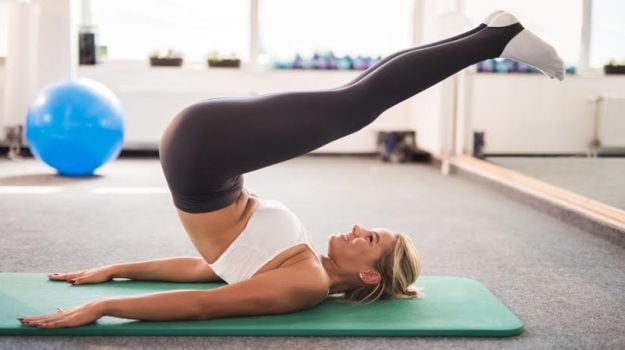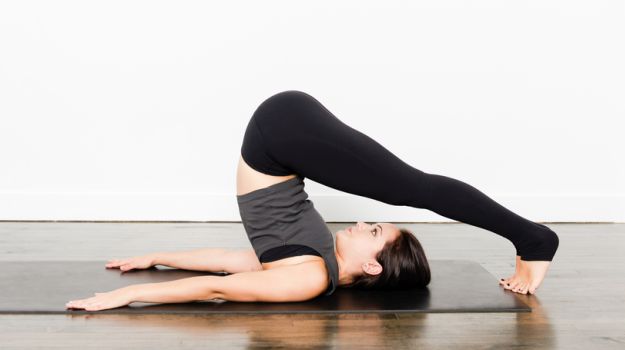I've always wanted to be able to take my legs over my head and hold the pose for as long as possible. It's a matter of pride, for me and the 698,000 people on Instagram who've got pictures tagged #yogaeverydamnday, #yogafitness and #wheelpose. Its popularity rests in the fact that it turns your world upside down, literally and figuratively. Allow me to explain. Over the course of two weeks, I've tried to challenge myself with a few difficult yoga asanas that I have always been afraid would actually snap my neck if I attempt to do them. So far, I've managed a crooked handstand, a 5-second Dharuasana and Halasana, which is what I'm going to talk about today. Despite the effort, the sheer sense of accomplishment it brings is worth it all.In the beginning, the Halasana pose seems downright uncomfortable. Your neck's bent inwards, your breathing is haphazard, and your toes are struggling to meet the ground. Slowly, but soon enough, you realise how practicing this pose and being able to hold it for more than 15 seconds can make your spine, neck, hamstrings and toes alert, and stretched out enough so your body feels open.'Hal' stands for 'plow' and 'Asana' stands for 'pose'. Halasana or 'the plough pose' takes its name from the farming instrument, plough, used by farmers across India to prepare the soil for sowing of seeds. In the sequence of asanas, Halasana is usually performed after Sarvangasana, which is basically a shoulder stand. According to Meenakshi Swami, the author of The Science of Yoga, "asanas like halasana, suryanamaskara, seershasana and kapalbharti increase the flow of blood to your head, improving intellectual power as well as memory."
It's one of those asanas which you can't perform half-heartedly because you may seriously injure yourself. You need to be extremely mindful, have great control over your breath and keep steady for at least 15 seconds. Once you build strength and flexibility, you can try and hold this pose for as long as 10 minutes.

Benefits of Halasana1. One of the most noticeable benefits of Halasana is the extreme stretch it gives to your back bone, right from the neck to the tail bone, releasing any muscular tension. Judith Lasater writes in the Yoga Journal, "All structures of the posterior spine are stretched, including muscles, ligaments, tendons, and fascia. In additions, the hamstring muscles - at the back of the thigh, in particular - receive quite a stretch as well."2. With age, your backbone tends to become stiff. Halasana works on the flexibility of your backbone and helps open up and strengthen it.3. BKS Iyengar, the founder of 'Iyengar Yoga' suggests that Halasana is extremely helpful for those suffering from hypertension or migraine.4. Swami Satyananda Saraswati writes in Asana Pranayama Mudra Bandha, "Halasana massages all the internal organs, activates digestion, relieves constipation, revitalises the spleen, suprarenal glands (which belong to the endocrine system and are placed over your kidneys), promotes the production of insulin by the pancreas and improves liver and kidney function."5. He adds, "Halasna also regulates activities of the thyroid gland which balances the body's metabolic rate, and stimulates the thymus gland, boosting the immune system."6. Shaili Singh, who holds a Masters Degree in Yoga and Science of Living from Jain Vishva Bharati Institute and a diploma in Yoga from Morarji Desai National Institute of Yoga, says, "it's really good to burn fat around the gut. Halasana also improves the functioning of the thyroid gland and improves blood circulation."Tips for Halasana1. The best way to do this asana is to place folded blankets under your shoulders. This lends some support to your upper body and neck.2. If you find it difficult to lift your hips off the ground, try placing a pillow under them. This should give you the initial push.3. Use both your hands to stabilise yourself and keep them there till you've safely placed your toes on the ground. Even the slightest movement could create imbalance and you could risk injury to your neck.4. For those with a stiffer back, try another version of Halasana, known as Ardhaasana where your legs are parallel to the floor and resting on a chair.5. Breathing - Inhale and hold on to your breath while you get into the pose. Exhale and then steady your breath while in the pose. When you want to resume your earlier position, breathe and hold on to it again.

How to do Halasana1. Grab a mat and lie down straight with your hands on the side.2. Slowly raise your legs together followed by your hips. At this point you can also use your hands to support your back.3. Take your legs backwards, over your head, towards the floor.4. Gently, place your toes on the ground. Then, place your arms back on the side.5. Hold this pose for as long as you can and while you do, breather slowly and keep looking forward.6. As the blood rushes to your head, pace your breath and count to 100.7. Once you're done, hold your lower back with your hands and bring your legs back to lie down straight. Exhale while you do this.Just to be sure you're doing it right, watch this:
It's one of those asanas which you can't perform half-heartedly because you may seriously injure yourself. You need to be extremely mindful, have great control over your breath and keep steady for at least 15 seconds. Once you build strength and flexibility, you can try and hold this pose for as long as 10 minutes.

Benefits of Halasana1. One of the most noticeable benefits of Halasana is the extreme stretch it gives to your back bone, right from the neck to the tail bone, releasing any muscular tension. Judith Lasater writes in the Yoga Journal, "All structures of the posterior spine are stretched, including muscles, ligaments, tendons, and fascia. In additions, the hamstring muscles - at the back of the thigh, in particular - receive quite a stretch as well."2. With age, your backbone tends to become stiff. Halasana works on the flexibility of your backbone and helps open up and strengthen it.3. BKS Iyengar, the founder of 'Iyengar Yoga' suggests that Halasana is extremely helpful for those suffering from hypertension or migraine.4. Swami Satyananda Saraswati writes in Asana Pranayama Mudra Bandha, "Halasana massages all the internal organs, activates digestion, relieves constipation, revitalises the spleen, suprarenal glands (which belong to the endocrine system and are placed over your kidneys), promotes the production of insulin by the pancreas and improves liver and kidney function."5. He adds, "Halasna also regulates activities of the thyroid gland which balances the body's metabolic rate, and stimulates the thymus gland, boosting the immune system."6. Shaili Singh, who holds a Masters Degree in Yoga and Science of Living from Jain Vishva Bharati Institute and a diploma in Yoga from Morarji Desai National Institute of Yoga, says, "it's really good to burn fat around the gut. Halasana also improves the functioning of the thyroid gland and improves blood circulation."Tips for Halasana1. The best way to do this asana is to place folded blankets under your shoulders. This lends some support to your upper body and neck.2. If you find it difficult to lift your hips off the ground, try placing a pillow under them. This should give you the initial push.3. Use both your hands to stabilise yourself and keep them there till you've safely placed your toes on the ground. Even the slightest movement could create imbalance and you could risk injury to your neck.4. For those with a stiffer back, try another version of Halasana, known as Ardhaasana where your legs are parallel to the floor and resting on a chair.5. Breathing - Inhale and hold on to your breath while you get into the pose. Exhale and then steady your breath while in the pose. When you want to resume your earlier position, breathe and hold on to it again.

How to do Halasana1. Grab a mat and lie down straight with your hands on the side.2. Slowly raise your legs together followed by your hips. At this point you can also use your hands to support your back.3. Take your legs backwards, over your head, towards the floor.4. Gently, place your toes on the ground. Then, place your arms back on the side.5. Hold this pose for as long as you can and while you do, breather slowly and keep looking forward.6. As the blood rushes to your head, pace your breath and count to 100.7. Once you're done, hold your lower back with your hands and bring your legs back to lie down straight. Exhale while you do this.Just to be sure you're doing it right, watch this:
Advertisement





